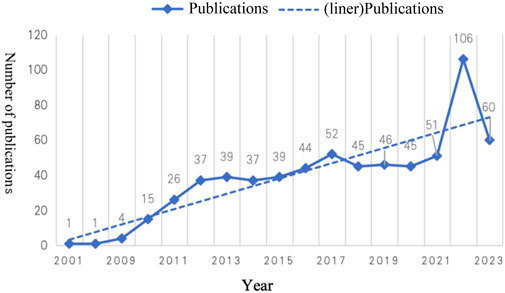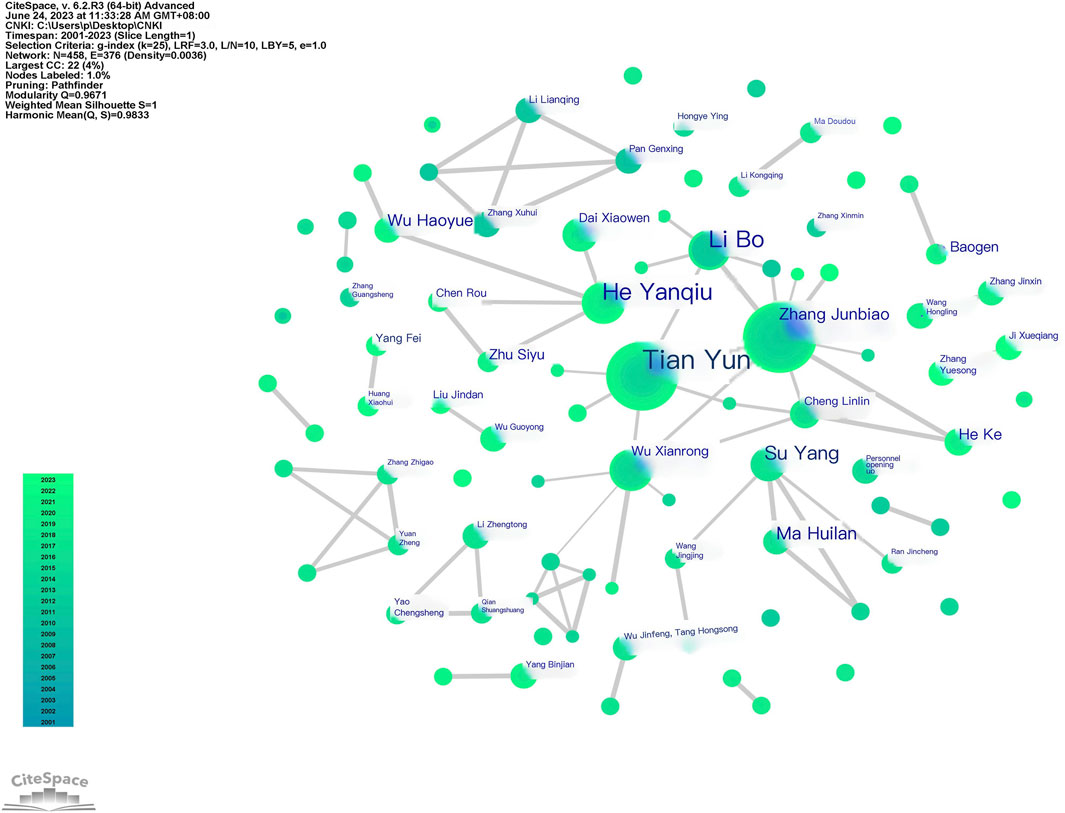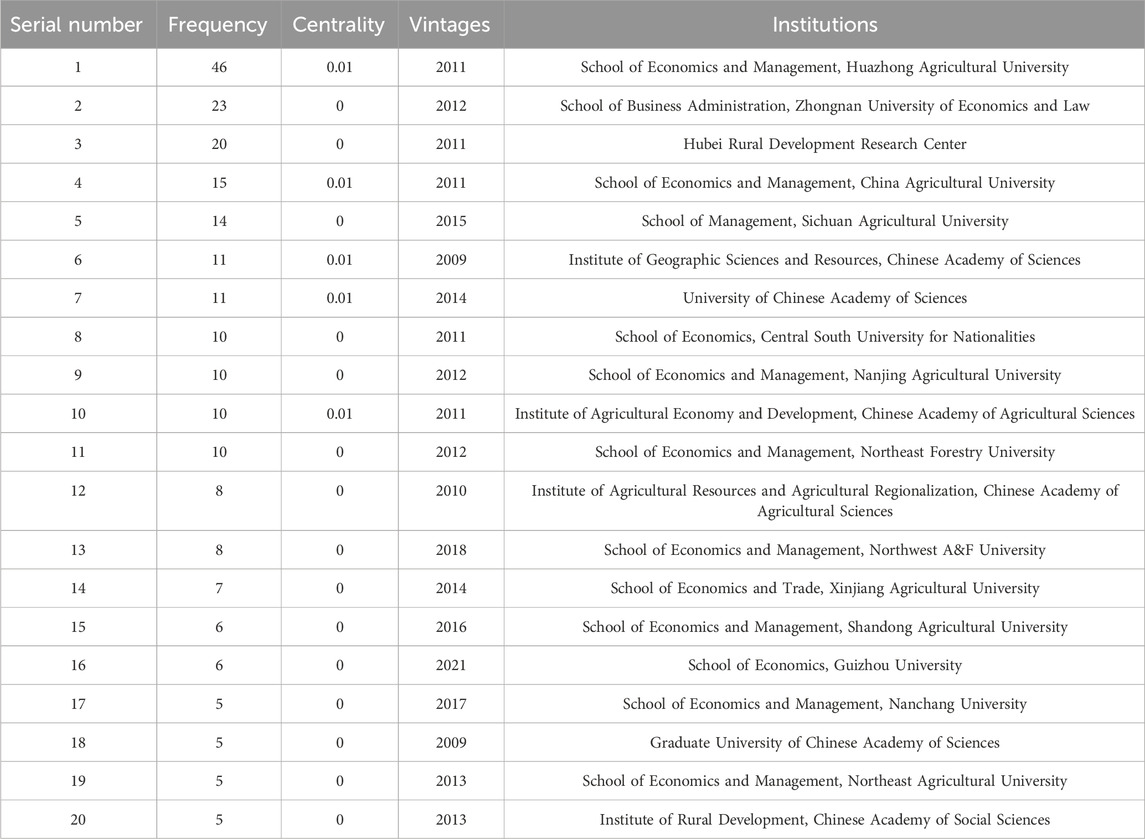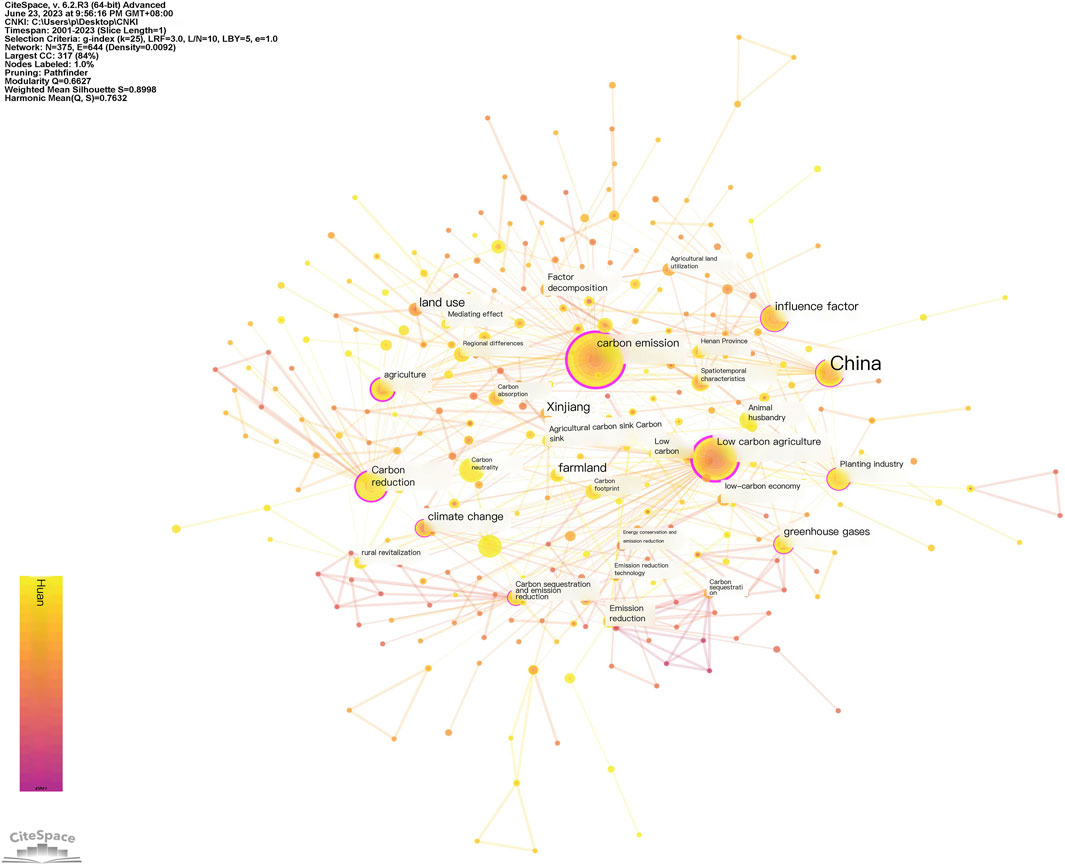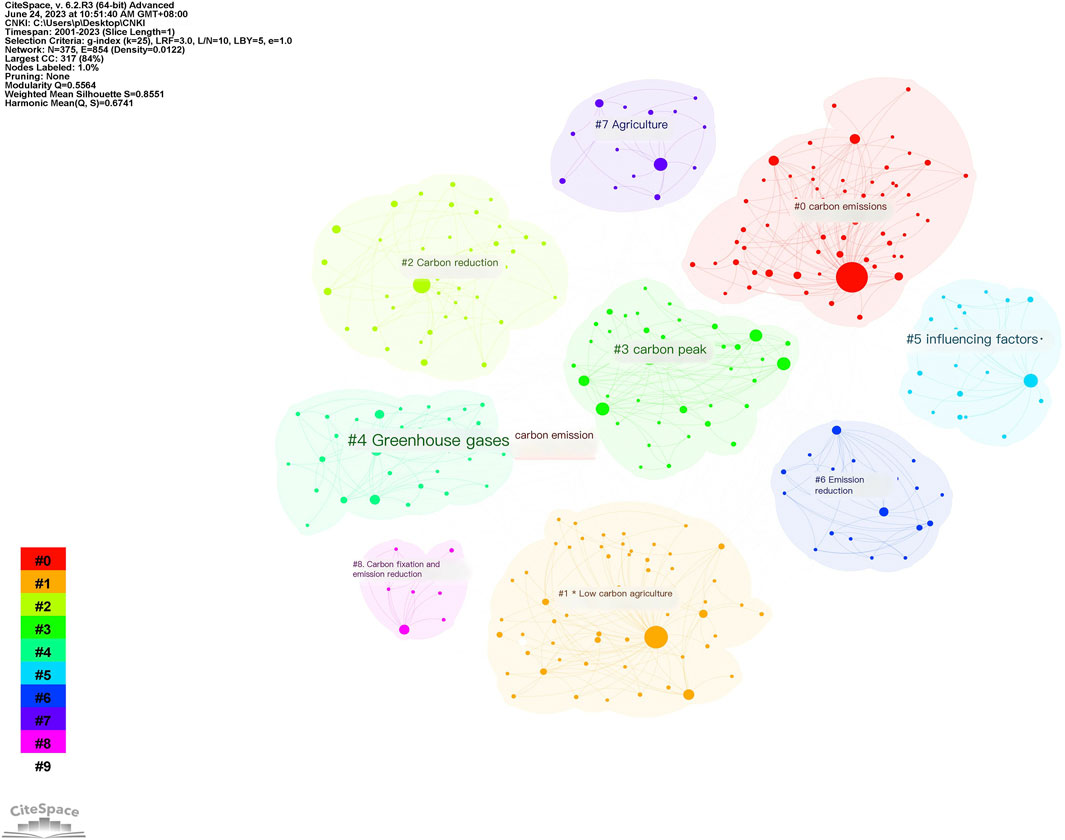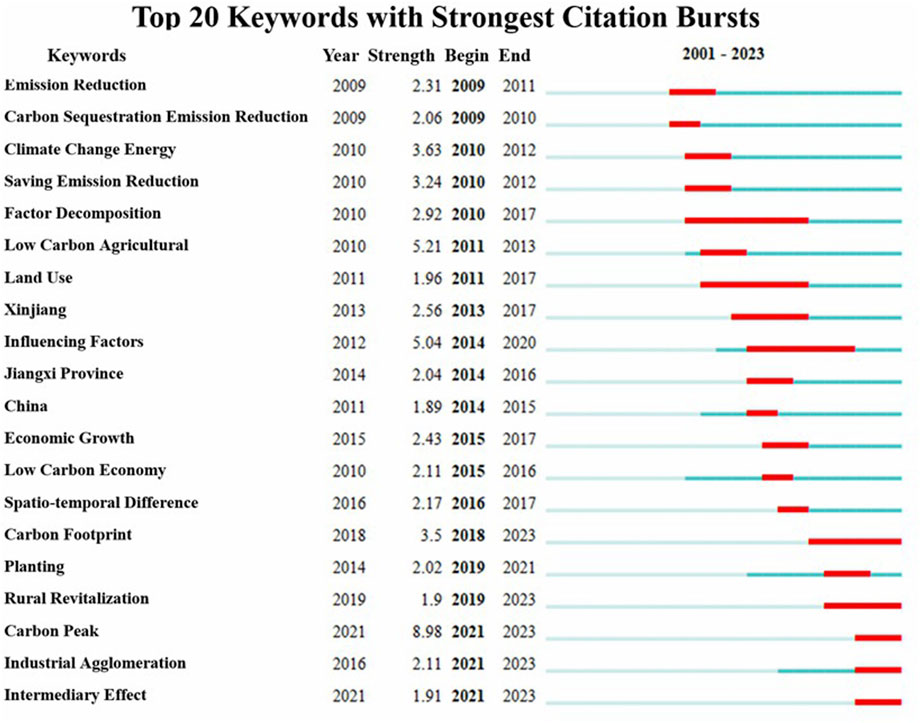- 1University of Glasgow, Glasgow, United Kingdom
- 2Guangdong University of Finance, Guangzhou, China
Agricultural activities constitute the second-largest contributor to greenhouse gas emissions. Proactively mitigating agricultural carbon emissions is crucial for safeguarding the ecological en-vironment, improving agricultural productivity, and fostering long-term ecological sustainability. This paper employs bibliometric analysis to examine the research status, hot topics, and devel-opment trends of agricultural carbon emissions in China over the past 2 decades. Based on Citespace software, the study primarily conducts visual analysis on 660 academic articles on ag-ricultural carbon emissions collected from the China National Knowledge Infrastructure (CNKI) between 2001 and May 2023, including publications indexed in Peking University Chinese Core Journals (PKU Core), Chinese Social Sciences Citation Index and Chinese Science Citation Database. The analysis covers publication quantity, author cooperation, institution cooperation, keyword co-occurrence, keyword clustering, keyword burst, keyword timeline, and keyword timezone. Research results indicate: (1) From the annual publication volume changes perspective, research on China’s agricultural carbon emissions demonstrates a rapid upward trend in the new era, with increasing research interest. (2) The core net-work of research authors has been established, primarily concentrated in agricultural and forestry universities, and the core network of institutions in this field is gradually forming. However, collaboration networks between authors and research institutions are relatively dispersed, necessitating strengthened collaboration among institutions. (3) Current research on agricultural carbon emissions predominantly focuses on the challenges of reducing agricultural carbon emissions in China under the “dual carbon” goals, measures, and pathways to achieve agricultural carbon emission reductions; performance evaluation of agricultural carbon emissions, factors affecting these emissions, and their reduction potential; as well as the relationship between agricultural carbon emissions and agricultural economic growth. Future research should delve deeper into the precise accounting of agricultural carbon emissions under the “dual carbon” goals, their underlying mechanisms, and issues related to precise and differentiated agricultural carbon reduction strategies. (4) The development trajectory of domestic agricultural carbon emissions research shows a period of germination from 2001 to 2009, a development stage from 2010 to 2015, and a deepening stage from 2016 to 2023, with a notable increase in publications in 2021, signifying a new upward phase in research output.
1 Introduction
Related research indicates that excessive carbon emissions in the sectors of agriculture, livestock, and industry adversely affect the development of climate, ecology, and human society. The processes of emission reduction associated with agricultural production, livestock, and industrial production are receiving significant attention (Abbas et al., 2023; Elahi et al., 2024; Elahi and Khalid, 2022; Odhiambo et al., 2020; Abbas et al., 2022; Waseem et al., 2022). Excessive carbon emissions can adversely impact climate, ecology, and human society (Kabir et al., 2023). The rise in carbon emissions leads to extreme and adverse weather conditions, further depleting the ozone layer, causing global climate warming, inducing the greenhouse effect, affecting the stability of the ecological environment, ultimately posing a threat to agricultural production, impacting global food yields, and endangering human survival (Huisingh et al., 2015). Currently, on a global scale, China is the largest carbon emitter. According to data from the “2023 China Agricultural and Rural Low-Carbon Development Report,” the total carbon emissions from agricultural production in China amount to 828 million tons of carbon dioxide, representing 6.7% of the nation’s total carbon emissions. While the overall proportion of agricultural carbon emissions may not be high, challenges persist, particularly concerning the significant release of harmful greenhouse gases from livestock farming and the increased carbon emissions due to excessive fertilizer use in agriculture (Raihan et al., 2023). Greenhouse gases generated from agricultural production mainly stem from livestock farming, fertilizer usage, agricultural land use, crop burning, and deforestation (Stavi and Lal, 2013). Therefore, improving agricultural production methods and land use practices is crucial to reducing carbon dioxide emissions.
In recent years, in response to the national “dual-carbon” goals, scholars have actively engaged in extensive research on agricultural carbon emissions, achieving fruitful outcomes. The academic community has made significant contributions in areas such as the estimation of agricultural carbon emissions, identification of influencing factors, and strategies for carbon reduction in agriculture (Huang et al., 2019; Litskas et al., 2007). Moreover, systematic reviews and analyses of research hotspots and trends in the field of agricultural carbon emissions in China have been further enriched. Currently, there is a limited number of comprehensive review articles on agricultural carbon emissions in China, primarily addressing topics such as the analysis of agricultural carbon effects, estimation of agricultural carbon emissions, low-carbon agriculture, and agricultural carbon emissions (Han et al., 2018; Zhu and Huo, 2022; Yun et al., 2014). Existing literature can be categorized into two main aspects: first, analyzing the current status and issues of agricultural carbon emissions through content and logical analysis (Zhao et al., 2021; Liu et al., 2020); second, visualizing the research hotspots and trends using Citespace software (Yu et al., 2023). However, there is currently limited research analyzing the research trajectory of agricultural carbon emissions, and there is a lack of in-depth analysis of research hotspots in this field.
To address this gap, this paper will employ CiteSpace software to visually analyze the historical evolution, research hotspots, and developmental trends of agricultural carbon emissions in China. The analysis will include examining collaboration relationships among the literature, research hotspots, and the evolution of research themes. While this study’s reliance on Citespace software and its focus solely on the CNKI database may introduce some limitations in generalizability, it is beneficial for highlighting China’s stance on carbon emission research. This approach allows for an in-depth exploration and analysis of China’s agricultural carbon emissions, offering new perspectives for researchers in the field, serving as a reference for subsequent studies, and promoting more systematic and comprehensive research on agricultural carbon emissions.
2 Literature background
The trend of agricultural carbon emissions in China shows an initial increase fol-lowed by a subsequent decrease, with varying growth rates evident in different stages (Liu et al., 2023; Chen et al., 2020a). Numerous scholars have systematically researched the issue of Chinese agri-cultural carbon emissions, which can be summarized in four main aspects: First, the estimation, spatiotemporal characteristics, and driving mechanisms of agricultural carbon emissions have been investigated (Dai et al., 2023). Second, scholars have analyzed the performance and assessed the reduction potential of agricultural carbon emissions (Li et al., 2023; Chen et al., 2023). In recent years, although agricultural production performance has improved, regional imbalances and spatial clustering effects have been prominent. Third, theoretical exploration and empirical testing of low-carbon agriculture have been conducted (Yang et al., 2023; Hao, 2022). Theoretical research has focused on the concepts, challenges, and development paths of low-carbon agriculture. Fourth, the relationship between agricultural industrialization and agricultural carbon emissions has been studied (Prastiyo et al., 2020; Dong et al., 2020). These studies contribute valuable insights into understanding and addressing the issue of agricultural carbon emissions in China.
3 Research methodology and data sources
3.1 Research methodology
Bibliometrics involves the statistical analysis of literature data to study the distribution structure, quantity relationships, and patterns of change in literature. It is a method used to predict the frontiers and trends in developing a discipline based on this analysis. CiteSpace, a widely used bibliometric software, was developed by a team led by Professor Chaomei Chen at Drexel University in the United States (Chen, 2006). It is based on co-citation analysis theory and pathfinding network algorithms. CiteSpace extracts and reconstructs information such as authors, institutions, and keywords, enabling tracking hotspots and development trends in research areas (Chen et al., 2012). Therefore, CiteSpace analysis can be used to study the trends and dynamics of the development of a discipline or knowledge domain over a certain period, such as research progress, frontiers, and knowledge foundations. It can also clarify complex relationships in citation networks, such as collaborative authors, institutions, journals, etc. CiteSpace helps answer questions such as: which literature is groundbreaking and landmark? What research topics dominate the field? How does the research frontier evolve? CiteSpace software has been applied in information science, education, economics, and management. This paper will use CiteSpace version 6.2. R3 to organize, analyze, and visualize literature information. The time interval is set from 2001 to 2023, with a time slice set to 1. Node types are selected as authors, institutions, and keywords, retaining the top 20 data for each time slice. The network graph is pruned using pathfinding, and other parameters are set to default values.
3.2 Data source
The China National Knowledge Infrastructure (CNKI) serves as a comprehensive full-text database, providing domestic and international readers with access to a wide array of resources including academic literature, Chinese scholarly documents, foreign language materials, and theses among others. As such, CNKI is frequently regarded as one of the primary sources for data collection in bibliometric analysis. The primary data source utilized in this study comprises the Chinese core journals list (as recognized by Peking University), the Chinese Social Sciences Citation Index (CSSCI), and the Chinese Science Citation Database (CSCD), all of which are accessible through the CBKI database.
The data was acquired on 12 June 2023, from the online database of Guangdong University of Finance Library. The search keywords were as follows: “agricultural carbon emissions” or “agricultural carbon reduction” or “crop production carbon emissions” or “livestock carbon emissions” or “agropastoral carbon emissions” or “agricultural energy carbon emissions,” covering the period from January 2001 to June 2023. A total of 834 original documents were initially retrieved. After eliminating duplicates, publications irrelevant to the topic, conference reviews, and non-academic documents such as news articles, a final set of 660 valid documents dated from 2001 to May 2023 was compiled. These documents form the foundational dataset for this research.
4 Bibliometric and analytical approach
4.1 Characteristics of temporal variation in publication volume
To understand the development trends in the field of agricultural carbon emissions in China, this study analyzed the changing trends in publication volume over time. As depicted in Figure 1, the overall research output in this field from 2001 to 2022 exhibits a linear upward trend. Additionally, the publication volume in this field shows distinct phased characteristics.
Between 2001 and 2023, the literature on agricultural carbon emissions in China can be broadly categorized into four stages: 2001–2009, 2010–2011, 2012–2020, and 2021–2023. From 2001 to 2009, the first stage represented the nascent phase of agricultural carbon emission research, characterized by an average publication output of 2 articles. During this period, China, in 2005, introduced the concept of “energy conservation and emissions reduction” in the 11th Five-Year Plan. Academic understanding of agricultural carbon emissions was limited, focusing primarily on soil respiration. During this phase, both the government and the general public had a relatively low awareness of energy conservation, with the primary focus being on promoting economic production extensively. The second stage, covering 2010–2011, witnessed a rapid increase in publication output. The second phase, spanning 2010–2011, is characterized by a rapid increase in the volume of publications. During this period, there was a noticeable rise in the number of articles related to agricultural carbon emissions, marking the first inflection point in the publication trend: the year 2010. The emergence of this inflection point can be attributed to the influence of the contemporary historical context of the time period: The notable surge was attributed to the “National Program for Addressing Climate Change in China” re-lease in 2007. Simultaneously, the 12th 5-year plan set targets for increasing low-carbon energy usage and reducing fossil energy consumption, prompting agricultural experts to delve into research on agricultural carbon effects. At the same time, the goals set forth in the “12th Five-Year Plan” significantly heightened the government and public’s attention to “low-carbon” initiatives and “energy conservation and emission reduction.” Within this historical context, there emerged a growing awareness that environmental protection should be considered alongside the promotion of production. The third stage, spanning 2012–2020, marked a period of stability in agricultural carbon emission re-search. The average publication output in this phase was 42 articles, indicating a significant increase. Additionally, the second critical period regarding agricultural carbon emissions emerged in 2012. The substantial increase in publication volume during this period can primarily be attributed to the Ministry of Agriculture issued opinions on further strengthening energy conservation and emission reduction in agriculture and rural areas in 2011. During this period, the “Dual Control Targets” were proposed under the “13th Five-Year Plan for Comprehensive Energy Conservation and Emission Reduction,” gradually drawing attention to agricultural carbon emissions. Simultaneously, the Paris Agreement, adopted in November 2016, has spurred Chinese scholars to intensify their research in the field of carbon emissions. By 2020, there was a 15% decrease in energy consumption per unit of GDP compared to 2015, with total energy consumption controlled within 5 billion tons of standard coal. This further heightened the focus on agricultural carbon emissions. As environmental issues have begun to impact the living conditions of the general public, attention to agricultural carbon emissions has significantly increased. The fourth stage, spanning 2021–2023, witnessed a secondary increase in publication output, This brings us to the third key point in the agricultural carbon issue: 2021. The renewed attention was associ-ated with the introduction of green and sustainable development in the 14th Five-Year Plan in 2020 and China’s formal commitment, at the 75th United Nations General Assembly, to achieve peak carbon emissions by 2030 and carbon neutrality by 2060–the “Dual Carbon” goals. From this analysis, it is evident that across these four stages, several inflection points have emerged, with particular emphasis on the years 2012 and 2021. During these 2 years, the volume of publications on the topic of agricultural carbon emissions experienced significant increases. The occurrence of these inflection points also reflects the specific historical context of those times, underscoring the increasing attention that the nation has been paying to environmental issues.
4.2 Co-citation analysis of literature
The citation frequency of referenced documents can elucidate their referential significance to the studied theme, with insights for research likewise stemming from these citations, literature with higher citation frequencies often indicates greater research value and significance. In the CNKI database, the top 10 journal articles on agricultural carbon emission research by citation frequency from 2001 to 2023 are presented in Table 1.
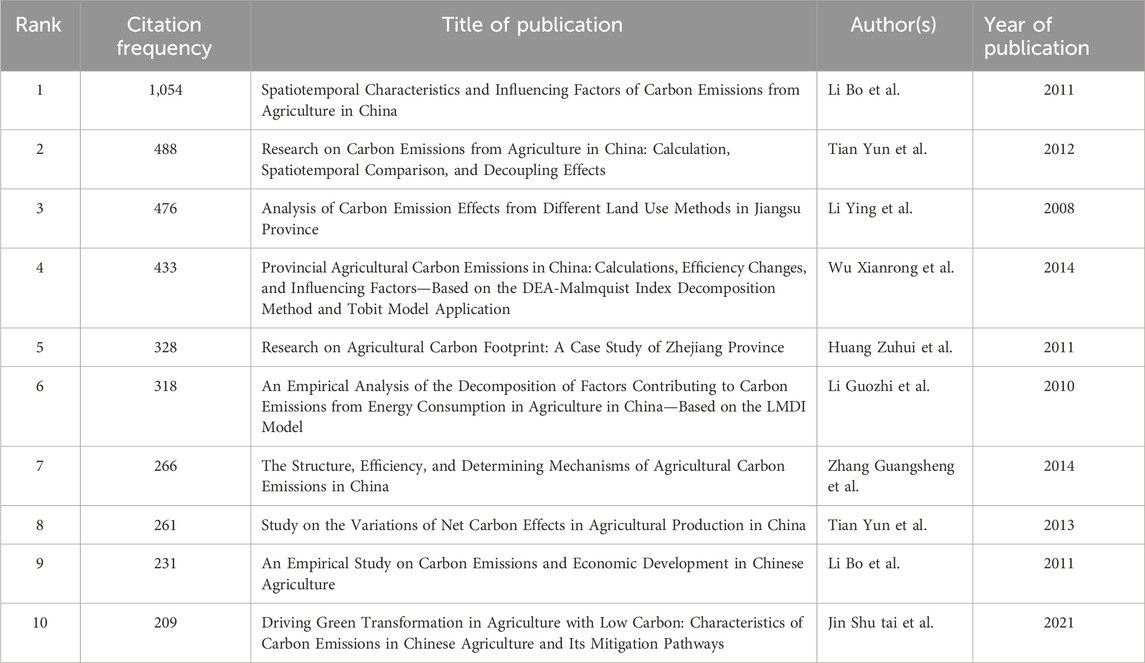
Table 1. Highly cited documents on agricultural carbon emissions research from 2001 to 2019 in CNKI database.
Within these documents, it is highlighted that the development of the agricultural economy is the primary factor leading to an increase in agricultural carbon emissions (Li et al., 2011), aligning with the findings of some scholars who have tested the Environmental Kuznets Curve (EKC) in relation to economic development and the agricultural resource environment. Currently, literature has discussed how both environmental quality and economic development in China’s central and western regions are positioned on the left side of the inverted U-shaped Environmental Kuznets Curve (Sun and Lin, 2018), further indicating that economic development will persist in degrading environmental quality (Chen et al., 2020b; Wang et al., 2019). It is also mentioned that as China’s agricultural economy develops, agricultural carbon emissions are expected to increase. In the foreseeable future, the main factors affecting the increase in China’s agricultural carbon emissions will continue to be the development of the agricultural and rural economy (Ran et al., 2011). Therefore, under rapid economic growth, there is a need for in-depth research on emission reduction technologies for agricultural carbon emissions and the associated policy guidelines.
4.3 Collaboration author co-occurrence analysis
The collaboration relationships among authors in the field can be intuitively understood through the co-authorship network diagram (Figure 2), The connections and colors between nodes represent the collaboration among authors, and the thickness of these lines indicates the degree of cooperation. The diagram consists of 458 nodes and 376 edges, with a network density of 0.0036, indicating relatively limited collaboration among authors, and the overall distribution of authors is relatively scattered.
From Figure 2, the co-authorship network, and Table 2, listing the top 20 authors by publication frequency, it is observed that Tian Yun has the highest publication output (36 articles), followed by Zhang Junbiao (35 articles), and He Yanqiu (13 articles). Subsequently, there are Wu Xianrong, Li Bo, and Dai Xiaowen. Eight authors, each with at least 6 publications, are identified, indicating a scarcity of highly productive authors.
The co-authorship network is notably evident in five pairs: Tian Yun and Zhang Junbiao, Wu Xianrong, Li Bo, etc.; Zhang Junbiao and Li Bo, Cheng Linlin, etc.; He Yan qiu and Dai Xiaowen, etc.; Pan Genxing and Zhang Xuhui, etc.; Su Yang and Ma Huilan, etc. The co-authorship networks suggest the formation of small-sized teams in the re-search of agricultural carbon emissions. According to Figure 2, it is evident that highly productive authors tend to collaborate more frequently.
In summary, the authors of publications on the agricultural carbon effect in China exhibit a state of “generally dispersed with localized concentration.” There are relatively few collaborative author groups. Moreover, the more common scenario is individual authors publishing independently.
4.4 Co-occurrence analysis of cooperating institutions
Utilizing CiteSpace to investigate the co-occurrence network of publishing institutions facilitates the exploration of collaborative relationships among various institutions within the field. The co-occurrence network diagram for institutions involved in agricultural carbon emissions research in China (Figure 3) encompasses 361 nodes and 242 edges, with a network density of 0.0037, The lines and colors between nodes represent the collaboration among institutions, and the density of these lines indicates the level of cooperation. This density indicates minimal collaboration among publishing institutions, reflecting an overall decentralized pattern of collaboration.
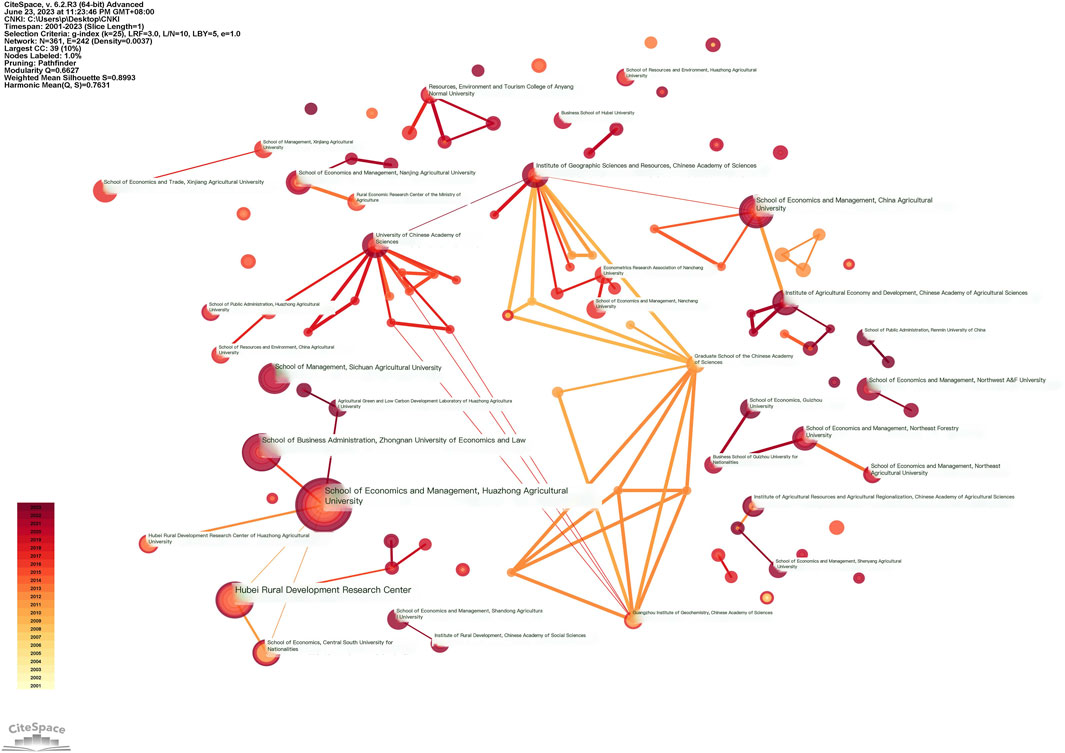
Figure 3. The cooccurrence network diagram for institutions involved in agricultural carbon emissions research in China.
Analysis of Figure 3; Table 3 reveals that the institution with the highest publication output is the School of Economics and Management at Huazhong Agricultural University, followed by the Business School at Zhongnan University of Economics and Law. Moreover, 13 institutions are contributing eight or more publications, primarily consisting of agricultural universities and, to a lesser extent, agricultural research institutes. In summary, two major collaboration networks have emerged within this re-search domain, led by the School of Economics and Management at Huazhong Agri-cultural University and the School of Economics and Management at China Agricultural University, respectively.
The Business School at Zhongnan University of Economics and Law, ranking second in publication output, collaborates solely with the School of Economics and Management at Huazhong Agricultural University without forming an extensive collaboration network. Additionally, two smaller collaboration networks have formed, led by the School of Economics and Management at Nanjing Agricultural University and the School of Economics and Management at Northeast Forestry University.
4.5 Co-occurrence analysis of keywords
Keywords serve as a concrete representation and refined summary of research topics. Analyzing high-frequency keywords allows for identifying research hotspots within a specific field. The frequency of keywords correlates positively with the quantity of research outcomes. The keyword co-occurrence network diagram (Figure 4) comprises 375 nodes and 644 edges, with a network density of 0.0092. In keyword co-occurrence network maps, there are two important metrics: “keyword frequency” and “keyword centrality.” Keywords are represented as nodes, where the size of a node indicates the frequency of the keyword’s occurrence. The larger the node, the more frequently the keyword appears in the dataset. Centrality reflects the status or importance of the keyword within the network of all keywords. To explore the status and relationships among keywords, the table presents the top 20 keywords by frequency and centrality (Table 4). The keyword co-occurrence knowledge graph and keyword intermediary centrality are shown in Figure 4; Table 3.
As indicated by Figure 4; Table 4, the most frequently occurring keyword is “carbon emissions,” followed by “low-carbon agriculture,” “carbon reduction,” “China,” “influencing factors,” “carbon neutrality,” “agriculture,” “planting industry,” “carbon peak,” and “greenhouse gas.” Table 3 reveals that “carbon emissions” has the highest intermediary centrality, followed by “China” and “influencing factors,” and then “carbon neutrality.” This suggests that the primary focus in agricultural carbon emissions lies in measuring agricultural carbon emissions, carbon reduction in agriculture, influencing factors, and carbon emissions from the planting industry.
5 Research hotspot and evolution trend
5.1 Research hotspot
Keyword cluster analysis involves categorizing all extracted keywords using CiteSpace, cluster analysis can be used to delineate related research fields. Previous research has suggested that a clustering module value exceeding 0.3 indicates a significant clustering structure and an average silhouette value exceeding 0.7 is considered an efficient clustering. Moreover, clustering is deemed reasonable when the average silhouette is 0.5 or higher. The keyword clustering graph (Figure 5) was obtained by adjusting parameters, resulting in a module value of 0.663, indicating a significant clustering structure, and an average silhouette value of 0.900, suggesting reasonable clustering results. There are eight clusters: carbon emissions, low-carbon agriculture, carbon reduction, carbon peak, greenhouse gases, influencing factors, emission reduction, agriculture, and carbon sequestration. The order ranges from 0 to 8, with smaller numbers indicating more keywords in the cluster. Each cluster comprises closely related words. Globally, the research directions concerning agricultural carbon emissions are divided into three main areas: measurement of agricultural carbon emissions, methods and policies related to agricultural carbon reduction, and the interrelationship between economic development and agricultural carbon emissions. As illustrated in Figure 5, the current research hotspots in China’s agricultural carbon emissions include topics such as carbon emissions, low-carbon agriculture, and carbon reduction strategies. By conducting cluster analysis on the keywords of relevant literature, the key research hotspots in China’s agricultural carbon emissions have been summarized as follows:
Under the “dual carbon” goals, China’s agricultural carbon emission reduction dilemmas, measures to achieve carbon reduction, and pathways for reduction are identified, including topics such as #2 low-carbon reduction, #3 carbon peaking, #6 emission reduction, and #8 carbon sequestration and reduction tags. For instance, the challenges faced by China in regulating agricultural carbon emissions are analyzed, and based on summarizing the advanced regulatory experiences of the European Union, Canada, Australia, Israel, and other countries, recommendations are proposed for establishing China’s top-level design for agricultural carbon emissions, perfecting agricultural carbon trading, constructing a comprehensive agricultural carbon system, and establishing a green finance support system (Jiang et al., 2021). Scholars have also proposed pathways for emission reduction by driving agricultural green transformation through low-carbon approaches (Jin et al., 2021); moreover, discussions have covered the greenhouse gas emission reduction pathways for northern agricultural ecosystems following the principles of stabilizing energy consumption and increasing both carbon sequestration and reduction, as well as four models of carbon sequestration and reduction including low-carbon cycling, capacity expansion and carbon increase, carbon-optimized breeding with nitrogen saving and carbon preservation (Cai and Wang, 2022).
The performance evaluation of agricultural carbon emissions, influencing factors, and the study of reduction potential, such as #0 carbon emissions and #5 influencing factors cluster tags. Scholars have analyzed the driving factors and mechanisms of cropland carbon emissions in the Northeast region (Zhou et al., 2021); meanwhile, the agricultural carbon emissions of the planting industry and livestock breeding in Jiangsu Province have been measured, and their emission performance and reduction potential evaluated (Chen et al., 2021); scholars have also studied the efficiency changes and influencing factors of provincial agricultural carbon emissions in China (Wu et al., 2014). Additionally, the efficiency and reduction potential of China’s agricultural carbon emissions have been analyzed (He et al., 2021), exploring the spatial spillover effects and influencing factors of agricultural carbon emission efficiency from industrial, elemental, and environmental perspectives, and analyzing the impact of policies in major grain-producing areas on agricultural carbon emissions (Wu et al., 2021).
The relationship between agricultural carbon emissions and agricultural economic growth, as identified by #1 low-carbon agriculture and #7 agriculture cluster tags. Scholars have measured the overall agricultural carbon emissions in Hubei Province using corresponding formulas, identifying the main factors affecting agricultural carbon emissions through factor decomposition, where the growth of the agricultural economy is found to continuously increase agricultural carbon emissions (Tian et al., 2012); similarly, an analysis of carbon emissions from agricultural energy consumption between 1981 and 2007 has revealed that economic growth leads to a significant increase in carbon increments, and the extensive use of pesticides and fertilizers exacerbates carbon emission issues (Li et al., 2011).
5.2 Evolution trend
Keyword burst analysis allows for the statistical tracking of the increased frequency of a specific keyword within a certain period, enabling the identification of development trends and research hotspots. Using CiteSpace software for burst detection in agricultural carbon emissions research, it is beneficial to understand the temporal evolution of hotspot keywords, providing insights into future trends. Burst detection was conducted on 660 documents, presenting a statistical graph of keyword bursts in agricultural carbon emissions research, as shown in Figure 6 for CNKI. In the graph, red indicates keywords that have burst during that specific year, and the length of the red segment represents the duration of the keyword’s sustained high frequency.
Based on the burst detection results shown in Figure 6, the keywords “factor de-composition,” “land use,” and “influencing factors” have long durations of 7 years, 6 years, and 6 years, respectively. The burst intensity of the keyword “carbon peak” is the highest, with a value of 8.98, occurring between 2001 and 2023. The burst analysis results indicate that early research focused mainly on analyzing emission reduction methods and factors influencing carbon emissions. In 2018, carbon footprint studies became a new hotspot in China, with a burst intensity of 3.50. Since 2019, keywords such as “planting industry” and “rural revitalization” have been continuously bursting. Starting in 2021, keywords like “carbon peak,” “industrial agglomeration,” and “mediation effect” may become future research hotspots.
Additionally, the co-occurrence time zone view of keywords can illustrate the co-occurrence relationships between keyword nodes, further identifying the evolutionary trajectory of the research subjects and enhancing the analysis of research trends. As shown in Figure 7, by retaining nodes with higher frequency and centrality based on the annual literature frequency chart, keyword co-linearity graph, and time zone atlas, this paper divides the research on agricultural carbon emissions into three stages: nascent phase, development phase, and in-depth phase. The period from 2001 to 2009 marks the nascent phase, where early research primarily focused on carbon emissions from agricultural soils. The development phase spans from 2010 to 2015, during which research on agricultural carbon emissions recognized regional and temporal differences. Studies concentrated on low-carbon economy, emission reduction technologies, and factors affecting agricultural carbon emissions in rural areas, with a significant emphasis on developing a low-carbon economy through land use, technology, and identifying impacting factors. The in-depth phase, from 2016 to 2023, saw an emergence of a wider array of keywords. Scholars have included industrial aggregation, rural revitalization, green agriculture, agricultural efficiency, mediating effects, digital agriculture, smart agriculture, and rural development in their analyses. Research on agricultural carbon emissions in China is currently in an in-depth phase, further exploring the impact of digital and smart agriculture on agricultural carbon emissions and their underlying mechanisms.
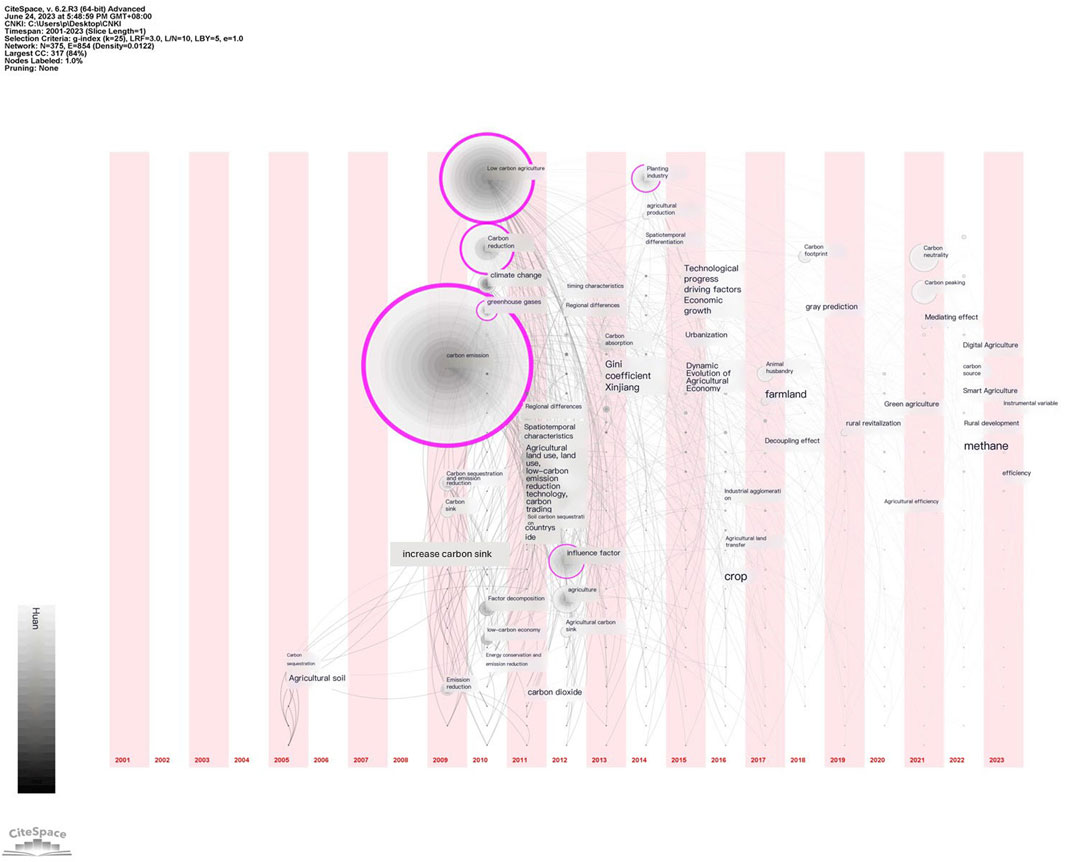
Figure 7. The knowledge graph of carbon emissions into three stages: nascent phase, development phase, and in-depth phase.
Moreover, future research should focus on cutting-edge trends and extensively explore the aforementioned three areas using advanced scientific methodologies. Efforts should include refining existing economic accounting mechanisms such as the input-output method and life cycle assessment, aiming to identify key methods for emission reduction. The development of smart agriculture and the improvement of current economic models are also crucial in finding effective carbon reduction strategies. Additionally, the implementation of a series of improved policies by the government and the establishment of interdisciplinary conferences and exchanges should be prioritized to foster collaboration and innovation in this field.
6 Conclusion and future trends
6.1 Research conclusion
This paper employs the Citespace bibliometric method to analyze 660 Chinese documents sourced from the CNKI database, focusing on the research trajectories, hotspots, and future trends in agricultural carbon emissions in China. The findings reveal:
Firstly, the annual publication volume trend indicates a rapid development in the research of agricultural carbon emissions in the new era, with increasing research popularity and influence. Since 2001, research on agricultural carbon emissions has gradually increased, with a stable development between 2012–2020. The year 2020 marks a watershed moment, integrating green sustainable development with agricultural carbon emissions into a common analytical framework. Secondly, the core network of research authors is well-established; conversely, the cooperation among research institutions is loose, indicating a need for strengthened scientific collaboration. Tian Yun is the most published author, followed by Zhang Junbiao and He Yanqiu. Research institutions are mostly concentrated in agricultural and forestry universities, with the College of Economics and Management of Huazhong Agricultural University being the most prolific. The primary reasons for the relatively loose structure of the research may stem from factors such as regional variations and limited relevance of research directions. In the future, it is crucial to strengthen connections between research institutions at major Chinese universities. Researchers should engage in exchanges and collaborations based on their respective research directions, and initiate academic exchanges and cooperative activities. This approach will not only increase the quantity of research outputs but also enhance their quality. Thirdly, according to the keyword co-occurrence knowledge map and keyword clustering knowledge map, research on agricultural carbon emissions mainly focuses on the challenges, measures, and pathways for reducing carbon emissions under the “dual carbon” goals; performance evaluation of agricultural carbon emissions, influencing factors, and research on reduction potential, and the relationship between agricultural carbon emissions and agricultural economic growth. Fourth, the keyword timeline map reveals an increase in publications on agricultural carbon emissions around 2010, reaching a new phase of increase in 2021. The keyword time zone map divides domestic research on agricultural carbon emissions into three phases: 2001–2009 as the nascent phase, 2010–2015 as the development phase, and 2016–2023 as the in-depth phase. The emergence of keywords such as “industrial agglomeration,” “digital agriculture,” “green agriculture,” and “smart agriculture” indicates that frontier research hotspots have shifted to technological innovation for emission reduction, green low-carbon agricultural development, and green finance supporting agricultural carbon reduction.
6.2 Policy implications
Utilizing big data technology to share agricultural, industrial, energy data, and carbon emission platforms can make agricultural carbon emission accounting more detailed and accurate. Integrating agricultural IoT and big data technologies into agricultural carbon reduction promotes differentiated and precise reduction while advancing agricultural economic development, leveraging digital technology’s role, and utilizing smart agriculture to provide technical support for agricultural environmental monitoring, improving agricultural development quality and efficiency, and accelerating agricultural green transformation and low-carbon development.
Promoting agricultural structural adjustment, encouraging agricultural technology innovation, optimizing land spatial layout, and improving land use efficiency, while coordinating agricultural carbon reduction with the treatment of agricultural non-point source pollution. In promoting agricultural carbon reduction measures, Some scholars emphasize targeted economic policies to mitigate these differences and enhance the positive effects of environmental decentralization. (Zhang et al., 2023). continuous subsidies for low-carbon behaviors such as film recycling, straw utilization, manure biogasification, and reduced use of fertilizers and pesticides through economic policies like taxes and subsidies are essential, encouraging agricultural enterprises to actively adopt low-carbon technologies. Additionally, accelerating the development of rural green finance, providing credit support to those involved in agricultural carbon reduction through green agricultural bonds, insurance, PPP projects, and other measures is vital.
Regions need to promote low-carbon agricultural development and optimize reduction pathways through scientific, feasible, refined, and differentiated strategies tailored to their resource endowments and development stages, leveraging the roles of government, market, and social organizations. Guiding farmers to adopt green low-carbon technologies such as drip irrigation, biogas fermentation, and soil testing and fertilization through agricultural extension and training, to facilitate the implementation of agricultural carbon reduction policies.
6.3 Research trends and outlook
Based on the current state and frontier trends of agricultural carbon emissions research, further in-depth studies should focus on the following aspects:
Agriculture serves as both a carbon source and sink. Under the “dual carbon” goals, it is crucial to systematically consider agricultural carbon sequestration and emission reduction within the green transformation of agriculture, establish a scientific and comprehensive agricultural carbon emission accounting system tailored to China’s context, and enhance research on the decoupling effect and mechanisms between agricultural carbon emissions and the economy, balancing “carbon neutrality” with food security, farmers’ income increase, social benefits, and ecological benefits.
For the performance evaluation and effect assessment of agricultural carbon emission reduction, it is essential to fully consider the concept of green development and “dual carbon” goals, balancing fairness and efficiency, and continuously study a systematic and scientific assessment system to scientifically evaluate the reduction costs and potential of different regions from social, economic, and ecological dimensions. For example, conducted a study on the impact of the government’s economic growth target on urban carbon emission, which is an example of a good combination of agricultural carbon emission and economy (Chen et al., 2023). Future studies can be further developed in this regard.
Further research is needed on the application boundaries of restrictive and incentive policies for agricultural carbon reduction, explore the influencing factors of farmers’ acceptance of low-carbon agricultural technologies, continue to focus on how to apply agricultural IoT and big data technologies to aid agricultural carbon reduction, and deepen the attention to agricultural technological innovation promoting carbon reduction.
Data availability statement
The raw data supporting the conclusions of this article will be made available by the authors, without undue reservation.
Author contributions
ZC: Methodology, Software, Writing–original draft. NL: Supervision, Writing–review and editing.
Funding
The author(s) declare that financial support was received for the research, authorship, and/or publication of this article. This research was supported by Hebei Social Science Foundation Project (No. HB23ZT024), Hebei Social Science Development Research Project (No. 20230203049), by Handan Social Science Federation Project (No. 2023064, 2023066), and by Handan Science and Technology Bureau Municipal Science and Technology R&D Plan Project (No. 23422903032).
Conflict of interest
The authors declare that the research was conducted in the absence of any commercial or financial relationships that could be construed as a potential conflict of interest.
Publisher’s note
All claims expressed in this article are solely those of the authors and do not necessarily represent those of their affiliated organizations, or those of the publisher, the editors and the reviewers. Any product that may be evaluated in this article, or claim that may be made by its manufacturer, is not guaranteed or endorsed by the publisher.
Supplementary material
The Supplementary Material for this article can be found online at: https://www.frontiersin.org/articles/10.3389/fenvs.2024.1359477/full#supplementary-material.
References
Abbas, A., Mushtaq, Z., Ikram, A., Yousaf, K., and Zhao, C. (2023). Assessing the factors of economic and environmental inefficiency of sunflower production in Pakistan: an epsilon-based measure model. Front. Environ. Sci. 11, 1186328. doi:10.3389/fenvs.2023.1186328
Abbas, A., Waseem, M., Ahmad, R., Khan, K. A., Zhao, C., and Zhu, J. (2022). Sensitivity analysis of greenhouse gas emissions at farm level: case study of grain and cash crops. Environ. Sci. Pollut. Res. 29 (54), 82559–82573. doi:10.1007/s11356-022-21560-9
Cai, Y., and Wang, L. (2022). Carbon sequestration and reduction pathways and models in typical northern agricultural ecosystems. Chin. J. Eco-Agric. Biling. 30 (04), 641–650.
Chen, C. (2006). CiteSpace II: detecting and visualizing emerging trends and transient patterns in scientific literature. J. Amer. Soc. Info. Sci. Tech. 57, 359–377. doi:10.1002/asi.20317
Chen, C., Hu, Z., Liu, S., and Tseng, H. (2012). Emerging trends in regenerative medicine: a scientometric analysis in CiteSpace. Exp. Op. Biol. Tx. 12, 593–608. doi:10.1517/14712598.2012.674507
Chen, M., Zhang, J., Xu, Z., Hu, X., Hu, D., and Yang, G. (2023). Does the setting of local government economic growth targets promote or hinder urban carbon emission performance? Evidence from China. Environ. Sci. Pollut. Res. 30, 117404–117434. doi:10.1007/s11356-023-30307-z
Chen, R., He, Y., Zhu, S., et al. (2020b). Study on the duality of China's agricultural carbon emissions and its coordination with economic development. Soft Sci. 34 (01), 132–138.
Chen, S., Zhang, K., and Zhang, Y. (2021). Measurement and decoupling effects of agricultural carbon emission performance. Stat. and Decis. 37 (22), 85–88.
Chen, X., Shuai, C., Wu, Y., and Zhang, Y. (2020a). Analysis on the carbon emission peaks of China’s industrial, building, transport, and agricultural sectors. Sci. Tot. Env. 709, 135768. doi:10.1016/j.scitotenv.2019.135768
Dai, X., Chen, Y., Zhang, C., He, Y., and Li, J. (2023). Technological revolution in the field: green development of Chinese agriculture driven by digital information technology (DIT). Ag. 13, 199. doi:10.3390/agriculture13010199
Dong, B., Ma, X., Zhang, Z., Zhang, H., Chen, R., Song, Y., et al. (2020). Carbon emissions, the industrial structure and economic growth: evidence from heterogeneous industries in China. Env. Pollut. 262, 114322. doi:10.1016/j.envpol.2020.114322
Elahi, E., and Khalid, Z. (2022). Estimating smart energy inputs packages using hybrid optimisation technique to mitigate environmental emissions of commercial fish farms. Appl. Energy 326, 119602. doi:10.1016/j.apenergy.2022.119602
Elahi, E., Li, G., Han, X., Zhu, W., Liu, Y., Cheng, A., et al. (2024). Decoupling livestock and poultry pollution emissions from industrial development: a step towards reducing environmental emissions. J. Environ. Manag. 350, 119654. doi:10.1016/j.jenvman.2023.119654
Han, H., Zhong, Z., Guo, Y., Xi, F., and Liu, S. (2018). Coupling and decoupling effects of agricultural carbon emissions in China and their driving factors. Env. Sci. Pollut. Res. 25, 25280–25293. doi:10.1007/s11356-018-2589-7
Hao, Y. (2022). The relationship between renewable energy consumption, carbon emissions, output, and export in industrial and agricultural sectors: evidence from China. Sci. Pollut. Res. 29, 63081–63098. doi:10.1007/s11356-022-20141-0
He, Q., Zhang, H., and Zhang, J. (2021). The nonlinear impact of agricultural industrial agglomeration on agricultural carbon emissions. Stat. and Decis. 37 (09), 75–78.
Huang, X., Xu, X., Wang, Q., Zhang, L., Gao, X., and Chen, L. (2019). Assessment of agricultural carbon emissions and their spatiotemporal changes in China, 1997–2016. Int’l J. Env. Res. Pub. Hlth. 16, 3105. doi:10.3390/ijerph16173105
Huisingh, D., Zhang, Z., Moore, J. C., Qiao, Q., and Li, Q. (2015). Recent advances in carbon emissions reduction: policies, technologies, monitoring, assessment and modeling. J. Clnr. Prod. 103, 1–12. doi:10.1016/j.jclepro.2015.04.098
Jiang, T., Liu, R., Bian, W., Li, B., Li, Y., Wang, S., et al. (2021). A novel protein encoded by circMAPK1 inhibits progression of gastric cancer by suppressing activation of MAPK signaling. Ningxia Soc. Sci. 20 (05), 66–73. doi:10.1186/s12943-021-01358-y
Jin, S., Lin, Y., and Niu, K. (2021). Driving agricultural green transformation with low carbon: characteristics of China's agricultural carbon emissions and their reduction pathways. Reform (05), 29–37.
Kabir, M., Habiba, U. E., Khan, W., Shah, A., Rahim, S., Farooqi, Z. U. R., et al. (2023). Climate change due to increasing concentration of carbon dioxide and its impacts on environment in 21st century; A mini review. J. of King Saud Univ-Sci 5, 102693.
Li, B., Zhang, J., and Li, H. (2011). Spatial and temporal characteristics of China's agricultural carbon emissions and factors decomposition. China popul. Resour. and Environ. 21 (08), 80–86.
Li, X., Hu, S., Jiang, L., Han, B., Li, J., and Wei, X. (2023). Bibliometric analysis of the research (2000–2020) on land-use carbon emissions based on CiteSpace. Ld 12, 165. doi:10.3390/land12010165
Litskas, V. D., Platis, D. P., Anagnostopoulos, C. D., Tsaboula, A. C., Menexes, G. C., Kalburtji, K. L., et al. (2007). “Climate change and agriculture: carbon footprint estimation for agricultural products and labeling,” in Sustainability of the food system. Editor B. Ester (FL: Academic Press Spain), 33–49.
Liu, L., Qu, J., Maraseni, T. N., Niu, Y., Zeng, J., Zhang, L., et al. (2020). Household CO2 emissions: current status and future perspectives. Int’l J. Env. Res. Pub. Hlth. 17, 7077. doi:10.3390/ijerph17197077
Liu, M., Chen, Y., Chen, K., and Chen, Y. (2023). Progress and hotspots of research on land-use carbon emissions: a global perspective. Sust 15, 7245. doi:10.3390/su15097245
Liu, Q., and Xiao, H. (2020). The impact of farmland management scale and fiscal policy for supporting agriculture on agricultural carbon emission. Resour. Sci. 42 (06), 1063–1073. doi:10.18402/resci.2020.06.05
Odhiambo, M. R., Abbas, A., Wang, X., and Elahi, E. (2020). Thermo-Environmental assessment of a heated venlo-type greenhouse in the Yangtze River delta region. Sustainability 12 (24), 10412. doi:10.3390/su122410412
Prastiyo, S. E., Irham, , Hardyastuti, S., and Jamhari, F. (2020). How agriculture, manufacture, and urbanization induced carbon emission? The case of Indonesia. Env. Sci. Pollut. Res. 27, 42092–42103. doi:10.1007/s11356-020-10148-w
Raihan, A., Muhtasim, D. A., Farhana, S., Hasan, M. A. U., Pavel, M. I., Faruk, O., et al. (2023). An econometric analysis of greenhouse gas emissions from different agricultural factors in Bangladesh. E. Nexus 9, 100179. doi:10.1016/j.nexus.2023.100179
Ran, G., Wang, J., and Wang, D. (2011). Study on the trend of carbon emissions from modern agricultural production in China. Issues Agric. Econ. 32 (02), 110–111.
Stavi, I., and Lal, R. (2013). Agriculture and greenhouse gases, A common tragedy. A review. Agro. Sust. Dev. 33, 275–289. doi:10.1007/s13593-012-0110-0
Sun, Y., and Lin, C. (2018). On environmental regulation and the quality improvement of China's economic growth: based on the environmental Kuznets inverted U-curve. Shanghai Econ. Res. (03), 84–94.
Tian, Y., and Lin, Z. (2021). The spatiotemporal coupling relationship between agricultural carbon emissions and economic growth in the yangtze river economic belt. J. China Agric. Univ. 26 (01), 208–218.
Tian, Y., and Yin, M. (2022). Re-Estimation of China's agricultural carbon emissions: basic status, dynamic evolution, and spatial spillover effects. China Rural. Econ. (03), 104–127.
Tian, Y., Zhang, J., and Li, B. (2012). Research on China's agricultural carbon emissions: estimation, spatial-temporal comparison, and decoupling effects. Resour. Sci. 34 (11), 2097–2105.
Wang, L., Yao, H., and Han, X. (2019). Carbon emissions, green total factor productivity, and agricultural economic growth. Explor. Econ. Issues (02), 142–149.
Wang, L., Zhao, J., and Chen, S. (2016). Analysis of carbon sources, sinks, and their footprint changes in shandong province's farmland ecosystems. J. China Agric. Univ. 21 (07), 133–141.
Waseem, M., Khurshid, T., Abbas, A., Ahmad, I., and Javed, Z. (2022). Impact of meteorological drought on agriculture production at different scales in Punjab, Pakistan. J. Water Clim. Change 13 (1), 113–124. doi:10.2166/wcc.2021.244
Wu, H., Huang, H., He, Y., et al. (2021). Measurement, spatial spillover, and influencing factors of China's agricultural carbon emission efficiency. Chin. J. Eco-Agric. Biling. 29 (10), 1762–1773.
Wu, X., Zhang, J., Tian, Y., et al. (2014). Provincial agricultural carbon emissions in China: estimation, efficiency changes, and influencing factors—based on DEA-malmquist Index decomposition method and tobit model application. Resour. Sci. 36 (01), 129–138.
Yang, S., Yang, D., Shi, W., Deng, C., Chen, C., and Feng, S. (2023). Global evaluation of carbon neutrality and peak carbon dioxide emissions: current challenges and future outlook. Env. Sci. Pollut. Res. 30, 81725–81744. doi:10.1007/s11356-022-19764-0
Yu, Z., Wang, Y., Zhao, B., Li, Z., and Hao, Q. (2023). Research on carbon emission structure and model in low-carbon rural areas: bibliometric analysis. Sust. 15, 12353. doi:10.3390/su151612353
Zhang, J., Yang, G., Ding, X., and Yichan, L. (2023). Can two-way FDI synergy promote regional high-quality green development under environmental decentralization? Environ. Dev. Sustain. doi:10.1007/s10668-023-04120-0
Zhang, X., Qin, Y., Wu, L., et al. (2019). Progress in research on agricultural greenhouse gas emissions. J. Henan Univ. (Nat. Sci. Ed.) 49 (06), 649–662.
Zhao, Y., Ma, S., Fan, J., and Cai, Y. (2021). Examining the effects of land use on carbon emissions: evidence from pearl river delta. Int’l J. Env. Res. Pub. Hlth. 18, 3623. doi:10.3390/ijerph18073623
Zhou, S., Xi, F., Yin, Y., Bing, L. F., Wang, J. Y., Ma, M. J., et al. (2021). Accounting and drivers of carbon emission from cultivated land utilization in Northeast China. J. Appl. Ecol. 32 (11), 3865–3871. doi:10.13287/j.1001-9332.202111.003
Keywords: agricultural carbon emissions, low-carbon agriculture, bibliometric analysis, Citespase, development trends
Citation: Chen Z and Liu N (2024) Evolution of agricultural carbon emission research in China: a historical analysis and emerging trends. Front. Environ. Sci. 12:1359477. doi: 10.3389/fenvs.2024.1359477
Received: 21 December 2023; Accepted: 29 July 2024;
Published: 25 September 2024.
Edited by:
Xiaojun Deng, Zhejiang University of Finance and Economics, ChinaReviewed by:
Jijian Zhang, Jiangsu University, ChinaAdnan Abbas, Nanjing University of Information Science and Technology, China
Copyright © 2024 Chen and Liu. This is an open-access article distributed under the terms of the Creative Commons Attribution License (CC BY). The use, distribution or reproduction in other forums is permitted, provided the original author(s) and the copyright owner(s) are credited and that the original publication in this journal is cited, in accordance with accepted academic practice. No use, distribution or reproduction is permitted which does not comply with these terms.
*Correspondence: Na Liu, bGFuYTE2NjgyMDIzQDE2My5jb20=
 Ziying Chen1
Ziying Chen1 Na Liu
Na Liu